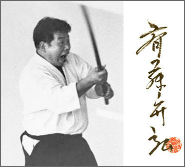Vincent Sumpter’s Story
 From 1974 to date, 6th Dan
From 1974 to date, 6th Dan
When did you start aikido and why?
I started my practice of aikido in Tokyo in 1974, aged 31. Just a month after arriving there for work in the British Embassy I saw an advertisement in the local English language paper inviting people to come to the American Embassy and try aikido under the instruction of a Hombu Shihan (Seijuro Masuda). I’ve never been good at any sport in the past but the description given of aikido was enough to persuade me to go along and at least give it a try.
The rest, as they say, is history. What I saw and got out of that first lesson was enough to make me want more – and much more. I was totally hooked from day one!
What are some of your main memories of aikido?
After a couple of months of training at the US Embassy I realised it wasn’t enough. I needed more training – and training hours – if I was to have any chance of completing the Hombu grading syllabus before my 3-year tour in Tokyo came to an end; towards the end of my tour I was doing 6-7 hours a week, mostly at the Hombu.
Of course, 1974-1977 were fantastic years for training at the Hombu. I had the pick of classes that I could attend, under the instruction of O-Sensei’s direct students: Doshu Kisshomaru, Shihans Yamaguchi, Osawa, Masuda, Watanabe, Chiba, and many more. As a consequence, I suppose I developed a rather eclectic traditional style.
That said, Shihan Masuda taught the use and value of the Bokken and Jo as part of my aikido training and development. Specifically, and under his instruction, I learnt the suburis and katas as taught in the “Iwama” style. He must, at some time, have taken instruction with or under Shihan Saito.
Did I achieve my goal in my time in the British Embassy? Well, yes; I was awarded Shodan by the Doshu three weeks before I left Tokyo and was at last able to train at the Hombu wearing a hakama. A proud moment and one that is unforgettable.
What are your personal goals in aikido?
With so many years of training and teaching already behind me I’ve already achieved many of my personal goals. The best though is the joy of knowing you have students who carry on the ethos and training that you have instilled in them. I don’t have an ego any more about teaching and training. Now, it’s more about having confidence in what I do and the humility to know when the next step forward might be a step too far; that is, know your limits and pass the baton on to the next generation.
Why do you think Iwama aikido is so unique?
When I returned to the UK from Tokyo in 1977, aikido was still – relatively – a minor player on the martial arts scene. There were a handful of 2nd and 3rd Dans and not that many more 1st Dans. Even more surprising to me was that I didn’t know of any other aikidoka that new the bokken and jo suburis or the kumi-tachi and jo katas. I therefore thought my Club in Witney, Oxfordshire, was unique in teaching weapons as part of a training syllabus.
Five years later, I was posted to RAF Wyton, not far from Cambridge, and needed a new place to continue my aikido practice. So one night I turned up at the Howard Mallet Club run by Sensei Sargeant. Unfortunately – or perhaps ‘fortunately’ – Tony was away in New Zealand attending a Saito seminar there. It turned out that on that night I was the highest grade present and was a bit shocked to be invited to take the class! The club members didn’t know me at all, I didn’t know them; so what to do? There was a weapons rack on one wall so my first thought was, “Play it safe, do something they don’t do – do a jo kata”. Wow! What an awakening; they knew the suburis, and 31 and 13-count katas. We were on the same page – UNIQUE!
I may be a traditionalist aikidoka at heart but I know of no other weapons training syllabus that so captures and teaches the relationship of the weapons suburis and katas with aikido principles and techniques. If you follow the Iwama weapons principles you can relate them to your particular style of aikido. That in itself is ‘unique’.
What can aikido offer people in your opinion?
Many things: keep fit, meaningful friendships, well-being, confidence; but ultimately, a way of life and one that can still be practised when you are old and grey! It has consumed me despite the fact that I also find it exasperating. Don’t expect to ever master it. You can become good and, perhaps with more time, better. But sadly, the more you learn the less – in reality – you find you know.
How long have you been training?
Too long, and not long enough!
Where have you travelled?
Aikido has given me a wonderful and varied life travelling the world in both teaching and training in aikido and, most thankfully, I had a wife who knew I needed the adrenalin rush of these trips. I’ve had my 3 minutes of fame, having made it on to both French and Italian TV sports channels but I have lasting memories of the annual teaching trips to Aosta, Italy, since 1987, 4 trips I made to Minsk, Belarussia, teaching “Iwama” weapons to the “Hombu” traditional group there; and, like all the other trips, the long-lasting friendships that are forged in these training seminars.
My story
My relationship with Tony Sensei, which started after my first visit to his Cambridge Dojo, has been a long and very fulfilling one – and continues to be so. We are close friends and – I like to think – kindred spirits. I have learnt so much from him. And, despite me not being a true adherent to Iwama aikido, he has selflessly given so much of himself to my development as a practitioner of aikido. For which I will be forever grateful.


